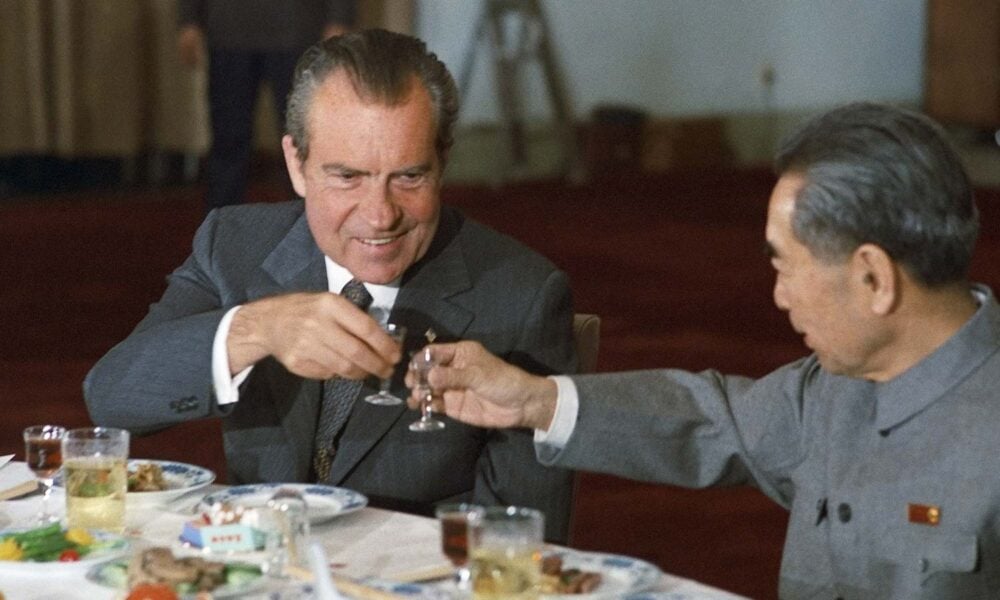US President Richard Nixon told Chinese Premier Zhou Enlai the United States recognized Taiwan was a part of China. Nixon made the statement during secret talks conducted during his historic visit to China in 1972. But what Nixon said in secret was intentionally obscured in the joint communiqué the two governments issued after the talks concluded.
This extraordinary act of deception, mistakenly heralded as an act of diplomatic genius, created a long-lived misunderstanding about US policy towards Taiwan that continues to poison US-China relations to this day.
Taiwan belongs to China
Declassified transcripts of Nixon’s conversations with Zhou Enlai make it clear Nixon told Zhou the United States recognizes Taiwan is a part of China. Here is what Nixon said to Zhou during the opening minuets of the first day of talks on Tuesday, February 22 in the Great Hall of the People in Beijing.
Now if we could turn and, as we have discussed, begin with the subject of Taiwan briefly at this point on things regarding which there is no disagreement. … Principle one. There is one China, and Taiwan is a part of China. There will be no more statements made–if I can control our bureaucracy–to the effect that the status of Taiwan is undetermined.
There’s no ambiguity in Nixon’s statement. But there is in the joint communiqué issued five days later.
The United States acknowledges that all Chinese on either side of the Taiwan Strait maintain there is but one China and that Taiwan is a part of China. The United States Government does not challenge that position. It reaffirms its interest in a peaceful settlement of the Taiwan question by the Chinese themselves.
This language leaves open the possibility that many people on Taiwan might not consider themselves to be Chinese, or, even if they do, that they could change their mind on whether Taiwan is a part of China. As I mentioned in an earlier post, that’s exactly what’s happened.
Which statement is the US government obliged to respect? The unambiguous assurance Nixon gave to Zhou, or the fuzzy language in the joint communiqué?
Word and deeds
“The problem here,” Nixon told Zhou, “is not what we are going to do, the problem is what we are going to say about it.” Nixon worried that US opponents of their agreement on Taiwan “might seize on the language we finally agree upon to attack the whole trip.”
Nixon warned Zhou they could not allow “this strong coalition of opponents” to claim he “went to Peking and sold Taiwan down the river.” The language on Taiwan in the joint communiqué, Nixon pleaded, needed to be “clever enough” to allow China to claim the United States agreed that Taiwan is a part of China while, at the same time, allowing Nixon to avoid admitting to Congress and the US public that he agreed to that claim.
So from the beginning, the language on Taiwan in what came to be called the Shanghai Communiqué was intended to be a lie, told with China’s agreement at the request of the United States.
President Carter began the final diplomatic push to normalize relations with China shortly after he assumed office in 1977. His national security advisor, Zbignew Brzezinski, examined more than a thousand pages of “verbatim transcripts” of the 1972 talks between the Nixon, Kissinger, Mao Zedong and Zhou Enlai. Brzezinski informed Carter that Nixon’s promises on Taiwan constituted a “secret pledge.”
Carter sent Brzezinski to Beijing in May 1978 to tell Chinese leader Deng Xiaoping the US would honor that pledge. Seven months later, without disclosing the United States had agreed Taiwan was a part of China, Carter severed US relations with the government on Taiwan and established formal diplomatic relations with the People’s Republic of China.
Bad faith
Nixon and Carter kept Congress and the US public in the dark because they worried there was not enough US domestic political support for their decision to acknowledge China’s sovereign claim to Taiwan in exchange for the establishment of diplomatic relations. For decades afterwards, US officials continued to publicly pretend that acknowledgment was never made while privately assuring the Chinese leadership the United States will continue to honor it.
The current Chinese leadership’s faith in those assurances is being severely tested as US-China relations deteriorate amid US talk of “decoupling” the world’s two largest economies. Both sides appear to be coping with an increasingly unstable status quo on Taiwan with preparations and threats to use force. The end result of the original act of bad faith on which the current relationship between the United States and China is founded could be a major war between two nuclear-armed nations.
Correcting the mistake that Nixon and Kissinger made in 1972 with their secret diplomacy on Taiwan will not be easy. But continuing to live with it will be even harder. The United States and China need to establish a new and more stable foundation for their relationship.
The featured image in this blog is of US President Richard Nixon and Chinese Premier Zhou Enlai toasting on February 25, 1972. Source: Richard Nixon Presidential Library and Museum.

